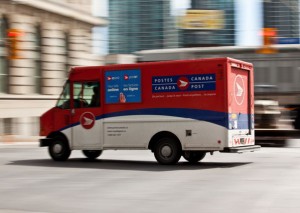
 The Canadian federal government recently announced that it will soon eliminate all door-to-door deliveries, even in urban areas (an idea which is getting some support with our neighbors south of the border).
The Canadian federal government recently announced that it will soon eliminate all door-to-door deliveries, even in urban areas (an idea which is getting some support with our neighbors south of the border).
Looking at this purely from a logistics standpoint (i.e. setting aside the obvious crown corporation vs. private sector disparities, and the loss of 8,000 jobs, etc.), I applaud the initiative, as it will eliminate a huge burden on the country’s finances (Canada Post is forecast to have an annual operating deficit of $1-billion by 2020).
Now let’s compare Canada Post’s delivery system with another industry that also relies on expensive delivery operations – The Foodservice industry.
A typical foodservice delivery route will have 10 to 20 stops, making it both time consuming and labor intensive. The same applies for the mail, in terms of a high “at stop time” to “travel time” ratio.
The question we need to ask though is what are those deliveries worth to each customer? In other words, are taxpayers and restaurants getting equal value for their money and are there other, more efficient or cheaper alternatives that would not decrease the perceived value of the service? >Tweet this<
In one case, there are several reasons why restaurants pay a premium for their goods. Variety of offerings is one of them. Another is the ability to order frequently and in small quantities. Ultimately, the end consumer sees value in paying for a delicious meal that was made with fresh, high-quality ingredients.
On the other hand, taxpayers are also paying a premium for a service that has seen its value decline steadily in recent years. Out of all the information you receive on daily basis through the mail, what percentage of it do you think could not have been delivered without the expensive labor & equipment required for door-to-door delivery by a letter carrier? Pretty slim if you ask me.
This reform makes a lot of sense since disruptive technology (the internet in this case) has proven to deliver a more efficient and cost-effective solution. Most of what we receive in the mail today already has an online counterpart: bills and credit card statements, government communications, advertisement, etc. And while the reform doesn’t affect outbound flows, most of what we send can also now be done online (pay your bills, change your address, register to an activity of some sort, etc.)
And with a 5-year phase out plan, everyone – people and companies alike – will have plenty of time to adapt their habits.
There are obviously valid arguments against the reform, like the impact on people with reduced mobility or other disabilities. My bet is that private businesses will emerge to cater to those who need or want to continue receiving home delivery.
But what about stuff that cannot be done online, like a cheerful Christmas card or a romantic love letter? Again, while not as “personal” as a handwritten note, it can still be done. Anyway, the mail is not being completely eliminated; you just may have to walk a few blocks to a community box to get your packages or correspondence.
And the fact that there aren’t any viable alternatives to foodservice delivery doesn’t mean that there isn’t room for improvement through the use of technology, better processes and efficient infrastructure design. So while we wait for digital food to be invented – and let’s hope this day never comes – we’ll just have to rely on foodservice distributors to keep on truckin’.
